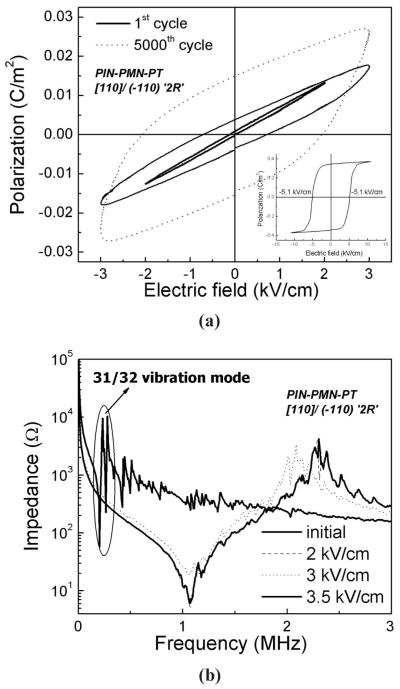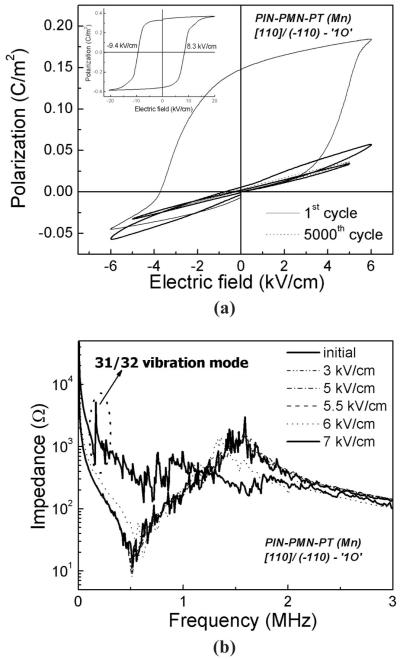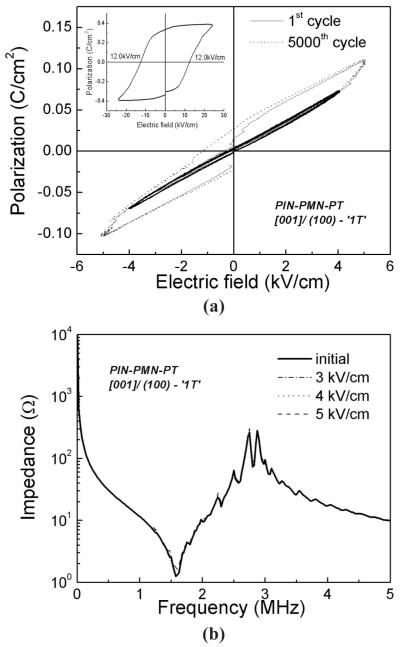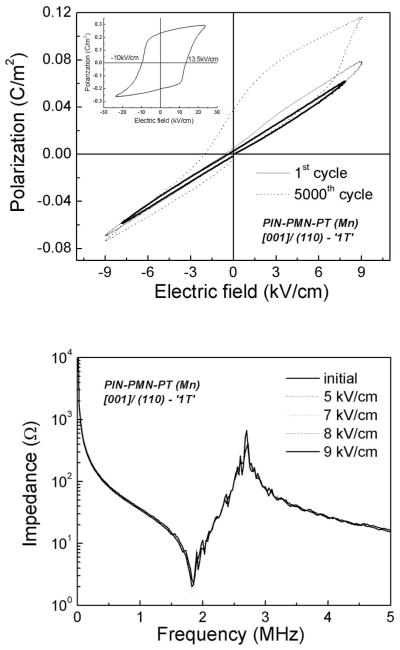Abstract
The coercive fields (EC) of Pb(In0.5Nb0.5)O3-Pb(Mg1/3Nb2/3)O3-PbTiO3 (PIN-PMN-PT) ternary single crystals were found to be 5 kV/cm, double the value of binary Pb(Mg1/3Nb2/3)O3-PbTiO3 (PMNT) crystals, further increased to 6 to 9 kV/cm using Mn modifications. In addition to an increased EC, the acceptor modification resulted in the developed internal bias (Eint), on the order of ~1 kV/cm. The piezoelectric shear properties of unmodified and Mn-modified PIN-PMN-PT crystals with various domain configurations were investigated. The shear piezoelectric coefficients and electromechanical coupling factors for different domain configurations were found to be >2000 pC/N and >0.85, respectively, with slightly reduced properties observed in Mn-modified tetragonal crystals. Fatigue/cycling tests performed on shear-mode samples as a function of ac drive field level demonstrated that the allowable ac field levels (the maximum applied ac field before the occurrence of depolarization) were only ~2 kV/cm for unmodified crystals, less than half of their coercive field. Allowable ac drive levels were on the order of 4 to 6 kV/cm for Mn-modified crystals with rhombohedral/orthorhombic phase, further increased to 5 to 8 kV/cm in tetragonal crystals, because of their higher coercive fields. It is of particular interest that the allowable ac drive field level for Mn-modified crystals was found to be ≥60% of their coercive fields, because of the developed Eint, induced by the acceptor-oxygen vacancy defect dipoles.
I. Introduction
The ultrahigh piezoelectric properties of relaxor-PT single crystals, exemplified in Pb(Mg1/3Nb2/3)O3-Pb-TiO3 (PMNT), have attracted considerable interest over the last two decades. Single-crystal compositions near their respective morphotropic phase boundaries (MPB) exhibit longitudinal piezoelectric coefficients (d33) greater than 1500 pC/N, with electromechanical coupling factors higher than 90%, along the pseudo-cubic [001] direction [1], [2]. These properties make relaxor-PT single crystals promising candidates for broadband and high-sensitivity ultrasonic transducers, sensors, and other electromechanical devices. Specifically, certain applications of sensors and transducers, such as accelerometers and non-destructive evaluation (NDE) transducers, require high piezoelectric shear coefficients d15. In rhombohedral relaxor-PT crystals, the highest shear values occur when poled along their [111] spontaneous polarization direction [3]–[10]. Piezoelectric coefficients (d15) and shear coupling factors (k15) have been reported to be >2000 pC/N and >0.9, respectively, relating to the facilitated polarization rotation in the single-domain state [11]–[13]. Unfortunately, their low coercive field values (EC), on the order of ≤2 kV/cm, limit their usage in applications where high drive is needed. In the ternary system Pb(In0.5Nb0.5)O3-Pb(Mg1/3Nb2/3) O3-PbTiO3 (PIN-PMN-PT), single crystals have been reported to possess higher EC, on the order of 5 kV/cm [14]–[16], associated with their higher Curie temperatures TC [17]. In related work by the authors, increased coercive field values were achieved through the addition of Mn, on the order of 6 to 9 kV/cm [18]. It is of particular importance that the modified PIN-PMN-PT crystals were found to possess a developed internal bias field (Eint), indicating the potential for high-power applications, where the field stability needs to be demonstrated.
In this work, the shear properties of both unmodified and Mn-modified PIN-PMN-PT crystals are studied, as a function of ac drive field, for various engineered domain configurations.
II. Experimental
Unmodified and Mn-modified PIN-PMN-PT single crystals were grown by the modified Bridgman technique along the crystallographic [001] direction [14]. Compositions with rhombohedral, orthorhombic, and tetragonal phases were selected in this work. The crystals were oriented along [001] and [110] crystallographic directions using a real-time back-reflection Laue system. Samples with dimensions of 5 × 5 × 0.5 mm were cut and polished with silicon carbide, and then electroded on the parallel surfaces by vacuum gold sputtering. Samples with rhombohedral phase were poled along the [110] direction at room temperature, using an electric field of 15 kV/cm, achieving an engineered domain configuration 2R. (2R is one of the domain-engineered structures designated according to the crystal phase and poling direction. For example, in crystals with rhombohedral phase, when poled along [110], the polar directions of the resultant set of equivalent domain variants are along [11–1] and [111], thus 2R domain engineered configuration is achieved [12], [13].) Samples with orthorhombic and tetragonal phases were poled along [110] and [001] directions, respectively, with electric field of 5 kV/cm and above their respective Curie temperatures, and then field cooled down to room temperature, achieving single-domain states 1O and 1T. After the poling process, the electrodes were removed and subsequently re-electroded on the large faces vertical to the original electrode planes, from which the shear vibration characteristics were determined. Schematic figures of the various shear mode crystal samples are shown in Fig. 1, including the standard crystal cut A: [111]/(1–10) (the first [hkl] is the poling direction, and the second (hkl) is the electroding surface), which is in rhombohedral phase and shows single-domain state 1R; other crystal cuts, B: [110]/(001) and C: [110]/(–110) are rhombohedral and/ or orthorhombic crystals with domain structures 2R or 1O after the poling process; D: [001]/(100) and E: [001]/(110) are tetragonal crystals with 1T domain states.
Fig. 1.
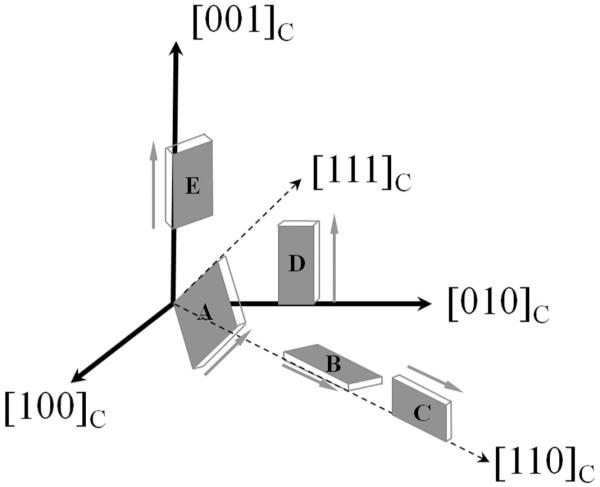
Schematic figure of the various shear mode samples of PIN-PMN-PT crystals. The arrows represent the poling direction. A: [111]/(1–10); B: [110]/(001); C: [110]/(–110); D: [001]/(100); E: [001]/(110).
High field measurements of polarization were performed using a modified Sawyer-Tower circuit. The coercive field and internal bias were obtained from the polarization versus electric field loops. The fatigue/cycling test frequency was selected to be 10 Hz, with a triangular waveform. The amplitude of the applied electric field was selected according to the level of coercive field of the given crystal, on the order of 0.5 to 10 kV/cm. To prevent electrical breakdown under electrical cycling, the samples were immersed in a silicone oil bath. The dielectric permittivities of various crystals were determined from the capacitances, measured using an HP4284A multi-frequency LCR meter (Agilent Technologies, Santa Clara, CA). The resonance and anti-resonance frequencies of the shear vibration modes were measured using an HP4294A impedance-phase gain analyzer (Agilent Technologies). The electromechanical coupling factors (k15) and resonance frequency N15 were calculated from the resonance and anti-resonance frequencies, according to IEEE standard on piezoelectricity [19].
III. Results and Discussion
Table I summarizes the shear properties of unmodified and Mn-modified relaxor-PT single crystals, in which 1O and 1T are in single-domain states, whereas the 2R configuration is in multi-domain state. The coercive fields EC of unmodified PIN-PMN-PT with R and/or O phases were found to be on the order of 5 kV/cm, further increased to 6 to 9 kV/cm for Mn-modified crystals, with internal biases Eint on the order of 0.6 to 1.2 kV/cm. The piezoelectric shear coefficients d15 and electromechanical coupling factors k15 for unmodified and Mn-modified crystals were found to be >2000 pC/N and >0.9, respectively. For tetragonal PIN-PMN-PT crystals, however, the piezoelectric coefficients and electromechanical coupling factors were found to be 1200 to 2200 pC/N and 0.77 to 0.85, respectively, lower than the R and/or O crystals. The coercive fields of tetragonal crystals were found to be 11 to 12 kV/ cm, much higher than R and/or O crystals, with developed internal bias on the order of 1.5 to 1.8 kV/cm for the modified crystals. Of particular interest is the ultralow-frequency constants, on the order of <400 Hz·m, as observed in crystals with 1O domain structure, which exhibit the potential for applications in low-frequency transducers. Based on their good shear properties, the crystals were further investigated under large drive signal to check the field stability behavior.
TABLE I.
Shear Mode Characteristics of Relaxor-PT Single Crystals With Various Domain Configurations.
| Poling/ electrode |
Engineered domain |
Crystal | EC (kV/cm) | Eint (kV/cm) |
∈ | d15 (pC/N) | k15 | N15 (Hz·m) | Allowable field level (kV/cm) |
Field stability ratio |
|---|---|---|---|---|---|---|---|---|---|---|
| 110/−110 | 2R (d15) | PIN | 5.0 | — | 6500 | 2800 | 0.92 | 570 | 2.0 | 40% |
| PIN-Mn | 7.3 | 1.2 | 4600 | 2200 | 0.91 | 520 | 5.0 | 68% | ||
| 110/−110 | 1O (d15) | PIN | 5.5 | — | 5600 | 3400 | 0.95 | 380 | 2.0 | 36% |
| PIN-Mn | 9.0 | 0.6 | 5800 | 3500 | 0.95 | 360 | 5.5 | 61% | ||
| 001/100 | 1T (d15) | PIN | 12.0 | — | 15000 | 2200 | 0.85 | 850 | 4.5 | 38% |
| PIN-Mn | 11.5 | 1.5 | 8000 | 1200 | 0.77 | 950 | 7.0 | 61% | ||
| 001/110 | 1T (d15) | PIN-Mn | 11.7 | 1.8 | 8000 | 1200 | 0.78 | 980 | 8.5 | 72% |
The polarization as function of cycling and drive level, for unmodified [110]/(–110) PIN-PMN-PT crystals with a 2R engineered domain configuration, is shown in Fig. 2(a). The small inset shows the polarization hysteresis measured at 10 kV/cm, from which the coercive field EC was found to be on the order of ~5 kV/cm for the [–110] oriented samples. For an ac drive field of 2 kV/cm, the polarization versus electric field (PE) exhibited linear behavior, indicating the samples were in the [110] poled status and no domain reversal occurred. For the drive field of 3 kV/cm, however, the PE curves became nonlinear, showing hysteretic behavior. The remnant polarization was found to increase to ~0.02 C/m2 after 5000 cycles, demonstrating partial depolarization occurred at this applied ac field. The impedance characteristics for the thickness shear vibration mode after cycling, as function of drive level, are shown in Fig. 2(b). The resonance frequency (fr) and antiresonance frequency (fa) of the virgin samples were found to be on the order of 1.0 and 2.3 MHz, respectively, with a calculated shear electromechanical coupling factor k15 of 0.92. The impedance frequency characteristics remained constant with increasing ac drive field level up to 2 kV/cm, corresponding to the linear PE behavior, as shown in Fig. 2(a). However, both fr and fa were found to shift, with reduced coupling on the order of 0.87, when the ac drive level was ≥3 kV/cm, corresponding to the hysteretic PE behavior. With further increased ac drive level, the shear impedance characteristics suddenly disappeared, and new vibration modes were observed in lower frequency range, corresponding to (–110)/[110] and (–110)/[001] extensional vibrations, where (–110) is the electrode face and [110]/[001] are vibration directions.
Fig. 2.
(a) Polarization as function of ac drive field and cycling for PIN-PMN-PT crystals with 2R domain structure; (b) impedance characteristics for thickness shear mode, after fatigue/cycling at different levels.
The polarization electric field behavior as function of cycling and drive field, for acceptor (Mn) modified [110]/ (–110) PIN-PMN-PT crystals with 2R engineered domain configuration, is shown in Fig. 3(a). The coercive field for Mn-modified crystals was found to increase to 7.3 kV/cm, with an internal bias on the order of 1.2 kV/cm, as shown in the small inset. The development of an internal bias is associated with acceptor (Mn)-oxygen vacancy defect dipoles MnTi”–VÖ, which move to the high-stressed areas of domain walls by diffusion and/or align along a preferential spontaneous polarization direction, pinning domain walls and thus stabilizing the domains [20], [21]. The build-up of these parallel defect dipoles to the local polarization vector leads to an offset of PE behavior or internal bias [20]. The impedance characteristics of thickness shear vibration mode after cycling, as function of drive level, are given in Fig. 3(b). For ac drive fields of 2 to 5 kV/cm (5000 cycles), the PE loops exhibited unchanged linear behavior as the first cycle, indicating that the Mn-doped crystals remained in the 2R engineered domain configuration and no domain reversal occurred. The field polarization stability can be confirmed by the impedance-frequency characteristic of the shear-vibrated samples, with same electromechanical coupling factors on the order of 0.91. Hysteretic behavior was observed in the PE curves, when the ac drive field level approaches 6 kV/cm (near the coercive field). As a consequence, the shear vibration characteristic disappeared, with a new extensional vibration mode appearing in the low-frequency range. Compared with the unmodified counterpart with same domain structure, Mn-modified PIN-PMN-PT crystals show higher coercive field and internal bias, allowing a much higher ac drive field level.
Fig. 3.
(a) Polarization as function of ac drive field and cycling for Mn-modified PIN-PMN-PT crystals with 2R domain structure; (b) impedance characteristics for thickness shear mode, after fatigue/cycling at different levels.
The ferroelectric and shear mode properties for Mn-modified [110]/(–110) PIN-PMN-PT crystals with 1O domain configurations are shown in Figs. 4(a) and 4(b), respectively. As discussed for Fig. 2 and Fig. 3, the stability of ac drive field for unmodified PIN-PMN-PT crystals with 1O engineered domain configuration was found to be only 2 kV/cm, whereas it was on the order of 5.5 kV/cm for the Mn-modified crystals with the same domain configuration, because of the higher coercive field and internal bias field in the modified crystals. To delineate the dominant factor for the allowable ac drive field level, the shear properties of tetragonal PIN-PMN-PT crystals were investigated, because similar EC values were found for unmodified and Mn-modified tetragonal PIN-PMN-PT crystals (on the order of ~12 kV/cm).
Fig. 4.
(a) Polarization as function of ac drive field and cycling for Mn-modified PIN-PMN-PT crystals with 1O domain structure; (b) impedance characteristics for thickness shear mode, after fatigue/cycling at different levels.
Fig. 5(a) gives the polarization behavior as function of cycling and ac drive field level, for unmodified [001]/ (100) tetragonal PIN-PMN-PT crystals with 1T domain configurations. The impedance characteristics for thickness shear vibration mode after fatigue cycling are shown in Fig. 5(b), where the fr and fa maintain the same values after the fatigue test at an ac drive level of 4 kV/cm, demonstrating no depolarization occurred, which can be confirmed by the linear PE behavior, as shown in Fig. 5(a).
Fig. 5.
(a) Polarization as function of ac drive field and cycling for PIN-PMN-PT crystals with 1T domain structure; (b) impedance characteristics for thickness shear mode, after fatigue/cycling at different levels.
The polarization behavior as a function of cycling and electric field drive level, for Mn-modified [001]/(110) tetragonal PIN-PMN-PT crystals with a 1T domain configuration, is shown in Fig. 6(a). The coercive field was found to be 11.7 kV/cm, with internal bias field on the order of 1.8 kV/cm, because of the Mn modification. The impedance characteristics for the thickness shear vibration mode after fatigue/cycling measurements at different drive levels are given in Fig. 6(b). Similar polarization behavior and impedance characteristics were observed, but with significantly higher allowable ac drive field (on the order of 8.5 kV/cm) than the unmodified counterparts.
Fig. 6.
(a) Polarization as function of ac drive field and cycling for Mn-modified PIN-PMN-PT crystals with 1T domain structure; (b) impedance characteristics for thickness shear mode, after fatigue/cycling at different levels.
The allowable ac drive field levels and field stability ratios (allowable ac drive fields divided by their respective coercive fields) for the studied crystals are listed in Table I. The allowable ac drive field level is only 2 kV/cm for unmodified PIN-PMN-PT with R/O phases, significantly enhanced in Mn-modified crystals and tetragonal crystals, because of their higher EC. It is interesting to note that the field stability ratios are on the order of ~40% for all of the unmodified PIN-PMN-PT, regardless of the high EC in tetragonal crystals, whereas the values increased to about 60 to 70% for the Mn-modified crystals, because of the presence of an internal bias. Furthermore, it was observed that field stability ratios increased with increasing internal bias level. Thus, the combination of high coercive field and internal bias give rise to the high allowable ac drive field, where the internal bias field improves the field stability ratio.
IV. Conclusion
The high shear piezoelectric properties of relaxor-PT single crystals with various domain configurations (d15 > 1200 to 3500 pC/N; k15 = 0.80 to 0.95) are promising for electromechanical applications such as NDE transducers, low-frequency sonar transducers, and others. In addition, the large allowable ac drive fields achieved in tetragonal and/or Mn-modified crystals (on the order of 4 to 9 kV/cm) make these crystals promising for high-power applications. The allowable ac drive field was thought to be related to the coercive field and internal bias, where the developed internal bias field in modified crystals offers higher field stability ratios than their unmodified counterparts.
Acknowledgments
The work was supported by NIH under Grant No. P41-EB21820 and ONR. The author F. Li (XJTU) acknowledged the National Basic Research Program of China (973 Program) under Grant No. 2009CB623306, International Science & Technology Cooperation Program of China under Grant No. 2010DFR50480, and the National Nature Science foundation of China (Grant No. 10976022 and No. 50632030).
Biographies
Shujun Zhang received his Ph.D. degree from The State Key Laboratory of Crystal Materials, Shandong University, China, in 2000. He is currently Senior Research Associate at the Material Research Institute and Associate Professor in the Materials Science and Engineering Department of The Pennsylvania State University. He is associate editor for the Journal of the American Ceramic Society. He is a senior member of the IEEE-UFFC society and a member of American Ceramic Society. He holds one patent and has coauthored more than 180 papers in the area of functional single crystals and ceramics. He is now focusing on the structure–property–performance relationship of high-temperature, high-power, and high-performance piezoelectric crystals and ceramics, for sensor and transducer applications.

Fei Li was born in Shannxi, China, in 1983. He received his B.Eng. degree in electronics science from Xi’an Jiaotong University, Xi’an, China, in 2006. He is currently pursuing his Ph.D. degree in the Electronic Materials Research Laboratory of Xi’an Jiaotong University, Xi’an, China. During September 2009 to September 2010, he worked in the Material Research Institute of The Pennsylvania State University. In his Ph.D. research, he is working in the field of piezoelectric and ferroelectric single crystals and ceramics.
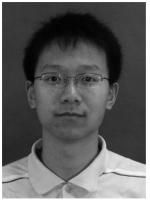
Jun Luo is a Research Scientist at TRS Technologies, Inc. He received his Ph.D. degree in materials science from the Shanghai Institute of Ceramics, Chinese Academy of Sciences (CAS) in 2000. From 2001 to 2002, he worked in Lightwaves 2020, Inc. as an R&D Engineer and developed new magneto-optical materials by the liquid phase epitaxy (LPE) technique for Faraday rotator application. From 2002 to 2004, he worked in the University of Central Florida as a Research Associate. During this period, he studied Czochralski growth of langasite and its isomorphs for high-precision bulk and surface acoustic waves (BAW & SAW) devices. His current research interest includes developing and processing advanced relaxor ferroelectric-based single-crystal materials for new piezoelectric sensors, actuators, and transducer applications.
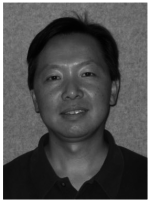
Ru Xia graduated from the Chemistry Department of Shandong University, China, in 1994. She is currently a Research Assistant at the Materials Research Institute of The Pennsylvania State University. Her research interest is material processing and characterization, including single crystals and polycrystalline ceramics.

Wesley Hackenberger has a B.S. degree in nuclear engineering and a Ph.D. degree in materials from The Pennsylvania State University. In 1995, Dr. Hackenberger joined TRS Technologies, Inc. as Director of R&D. He was named President of the company in 2003 and continues to serve in that capacity to the present day. At TRS, Dr. Hackenberger has been responsible for the development and commercialization several advanced materials technologies including single-crystal piezoelectrics, nonlinear dielectrics, high-energy-density capacitors, and ferroelectrics for pulsed power applications. Dr. Hackenberger is an author on more than 50 scientific publications and is listed as an inventor on 5 patents with more than 10 pending applications. Dr. Hackenberger currently manages both the commercial manufacturing and government contracting portions of TRS’s activities. TRS Technologies, Inc. is a developer and producer of advanced piezoelectrics and dielectrics for medical, industrial, and military applications.

Thomas R. Shrout is Professor of Materials and Senior Scientist at The Pennsylvania State University. He received B.S. and Ph.D. degrees in ceramic science from The Pennsylvania State University in 1976 and 1981, respectively. Prior to joining the faculty at Penn State, Dr. Shrout was with Sprague Electric Co. and AVX Co. He holds eighteen patents and has coauthored more than 300 papers in the area of electronic ceramics with an emphasis on processing property relationship.

Contributor Information
Shujun Zhang, Materials Research Institute, The Pennsylvania State University, University Park, PA (soz1@psu.edu).
Fei Li, Materials Research Institute, The Pennsylvania State University, University Park, PA (soz1@psu.edu); Electronic Materials Research Laboratory, Key Laboratory of the Ministry of Education, Xi’an Jiaotong University, Xi’an, P. R. China.
Jun Luo, TRS Technologies, Inc., State College, PA.
Ru Xia, Materials Research Institute, The Pennsylvania State University, University Park, PA (soz1@psu.edu).
Wesley Hackenberger, TRS Technologies, Inc., State College, PA.
Thomas R. Shrout, Materials Research Institute, The Pennsylvania State University, University Park, PA (soz1@psu.edu).
References
- [1].Park SE, Shrout TR. Ultrahigh strain and piezoelectric behavior in relaxor based ferroelectric single crystals. J. Appl. Phys. 1997;vol. 82(no. 4):1804–1811. [Google Scholar]
- [2].Zhang SJ, Luo J, Xia R, Rehrig PW, Randall CA, Shrout TR. Field-induced piezoelectric response in Pb(Mg1/3Nb2/3) O3–PbTiO3 single crystals. Solid State Commun. 2006;vol. 137(no. 1-2):16–20. [Google Scholar]
- [3].Zhang SJ, Lebrun L, Liu SF, Rhee S, Randall CA, Shrout TR. Piezoelectric shear coefficients of Pb(Zn1/3Nb2/3)O3–PbTiO3 single crystals. Jpn. J. Appl. Phys. 2002;vol. 41(no. 10A):L1099–L1102. [Google Scholar]
- [4].Zhang SJ, Lebrun L, Rhee S, Randall CA, Shrout TR. Shear-mode piezoelectric properties of PYN-PT single crystals. Appl. Phys. Lett. 2002;vol. 81(no. 5):892–894. [Google Scholar]
- [5].Zhang R, Jiang B, Cao W. Single-domain properties of 0.67Pb(Mg1/3Nb2/3)O3-0.33PbTiO3 single crystals under electric field bias. Appl. Phys. Lett. 2003;vol. 82(no. 5):787–789. [Google Scholar]
- [6].Peng J, Luo HS, Lin D, Xu HQ, He TH, Jin WQ. Orientation dependence of transverse piezoelectric properties of 0.70Pb(Mg1/3Nb2/3)O3-0.30PbTiO3 single crystals. Appl. Phys. Lett. 2004;vol. 85(no. 25):6221–6223. [Google Scholar]
- [7].Han PD, Yan WL, Tian J, Huang XL, Pan HX. Cut directions for the optimization of piezoelectric coefficients of lead magnesium niobate-lead titanate ferroelectric crystals. Appl. Phys. Lett. 2005;vol. 86(no. 5) art. no. 052902. [Google Scholar]
- [8].Jin J, Rajan KK, Lim LC. Shear resonance behavior of single-domain PZN-PT single crystals. IEEE Trans. Ultrason. Ferroelectr. Freq. Control. 2007;vol. 54(no. 11):2222–2226. doi: 10.1109/tuffc.2007.526. [DOI] [PubMed] [Google Scholar]
- [9].Liu SF, Ren W, Mukherjee BK, Zhang SJ, Shrout TR, Rehrig PW, Hackenberger W. The piezoelectric shear strain coefficient of ⟨111⟩-oriented PZN-PT piezocrystals. Appl. Phys. Lett. 2003;vol. 83(no. 14):2886–2888. [Google Scholar]
- [10].Liu XZ, Zhang SJ, Luo J, Shrout TR, Cao WW. A complete set of material properties of single domain 0.26PIN-0.46PMN-0.28PT single crystals. Appl. Phys. Lett. 2010;vol. 96(no. 1) doi: 10.1063/1.3275803. art. no. 012907. [DOI] [PMC free article] [PubMed] [Google Scholar]
- [11].Davis M, Budimir M, Damjanovic D, Setter N. Rotator and extender ferroelectrics: Importance of the shear coefficient to the piezoelectric properties of domain-engineered crystals and ceramics. J. Appl. Phys. 2007;vol. 101(no. 5) art. no. 054112. [Google Scholar]
- [12].Davis M, Damjanovic D, Hayem D, Setter N. Domain engineering of the transverse piezoelectric coefficient in perovskite ferroelectrics. J. Appl. Phys. 2005;vol. 98(no. 1) art. no. 014102. [Google Scholar]
- [13].Bell AJ. Phenomenologically derived electric field-temperature phase diagrams and piezoelectric coefficients for single crystal barium titanate under fields along different axes. J. Appl. Phys. 2001;vol. 89(no. 7):3907–3914. [Google Scholar]
- [14].Sherlock NP, Zhang SJ, Luo J, Lee HY, Shrout TR, Meyer RJ., Jr. Large signal electromechanical properties of low loss PMN-PT single crystals. J. Appl. Phys. 2010;vol. 107(no. 7) art. no. 074108. [Google Scholar]
- [15].Zhang SJ, Luo J, Hackenberger W, Shrout TR. Characterization of PIN-PMN-PT ferroelectric crystal with enhanced phase transition temperatures. J. Appl. Phys. 2008;vol. 104(no. 6) doi: 10.1063/1.2978333. art. no. 064106. [DOI] [PMC free article] [PubMed] [Google Scholar]
- [16].Zhang SJ, Luo J, Hackenberger W, Sherlock NP, Meyer RJ, Jr., Shrout TR. Electromechanical characterization of PIN-PMN-PT crystals as a function of crystallographic orientation and temperature. J. Appl. Phys. 2009;vol. 105(no. 10) doi: 10.1063/1.3131622. art. no. 104506. [DOI] [PMC free article] [PubMed] [Google Scholar]
- [17].Zhang SJ, Shrout TR. Relaxor-PT single crystals: Observations and developments. IEEE Trans. Ultrason. Ferroelectr. Freq. Control. 2010;vol. 57(no. 10):2138–2146. doi: 10.1109/TUFFC.2010.1670. [DOI] [PMC free article] [PubMed] [Google Scholar]
- [18].Zhang SJ, Luo J, Li F, Meyer RJ, Jr., Hackenberger W, Shrout TR. Polarization fatigue in PIN-PMN-PT single crystals. Acta Mater. 2010;vol. 58(no. 10):3773–3780. doi: 10.1016/j.actamat.2010.03.018. [DOI] [PMC free article] [PubMed] [Google Scholar]
- [19].IEEE Standard on Piezoelectricity. Vol. 176. ANSI/IEEE Std; 1987. [Google Scholar]
- [20].Zhang SJ, Lee SM, Kim DH, Lee HY, Shrout TR. Characterization of Mn-modified PMN-PZ-PT single crystals for high power broad bandwidth transducers. Appl. Phys. Lett. 2008;vol. 93(no. 12) doi: 10.1063/1.2992081. art. no. 122908. [DOI] [PMC free article] [PubMed] [Google Scholar]
- [21].Zhang LX, Erdem E, Ren XB, Eichel RA. Reorientation of (MnTi”-VO·)x defect dipoles in acceptor-modified BaTiO3 single crystals: An electron paramagnetic resonance study. Appl. Phys. Lett. 2008;vol. 93(no. 20) art. no. 202901. [Google Scholar]



